Announcing the winners of the Molecular Motifs bioart competition
We are pleased to announce the winners of the 2024 Molecular Motifs bioart competition!
This year, we received 37 entries from ASBMB members and collaborators across various career stages, from undergraduates to professors, representing both academia and industry, with submissions coming from as far away as Pakistan and Brazil, and covering topics such as microbiology, protein structure, cell biology and more.
The ASBMB membership committee and staff helped select the 12 winning works of art that will be featured in the 2025 ASBMB calendar.
Congratulations to the winners of the 2024 Molecular Motifs bioart competition!
Keep an eye out for your 2025 calendar — it will be mailed to ASBMB members with the November issue of ASBMB Today.
This year’s winners:
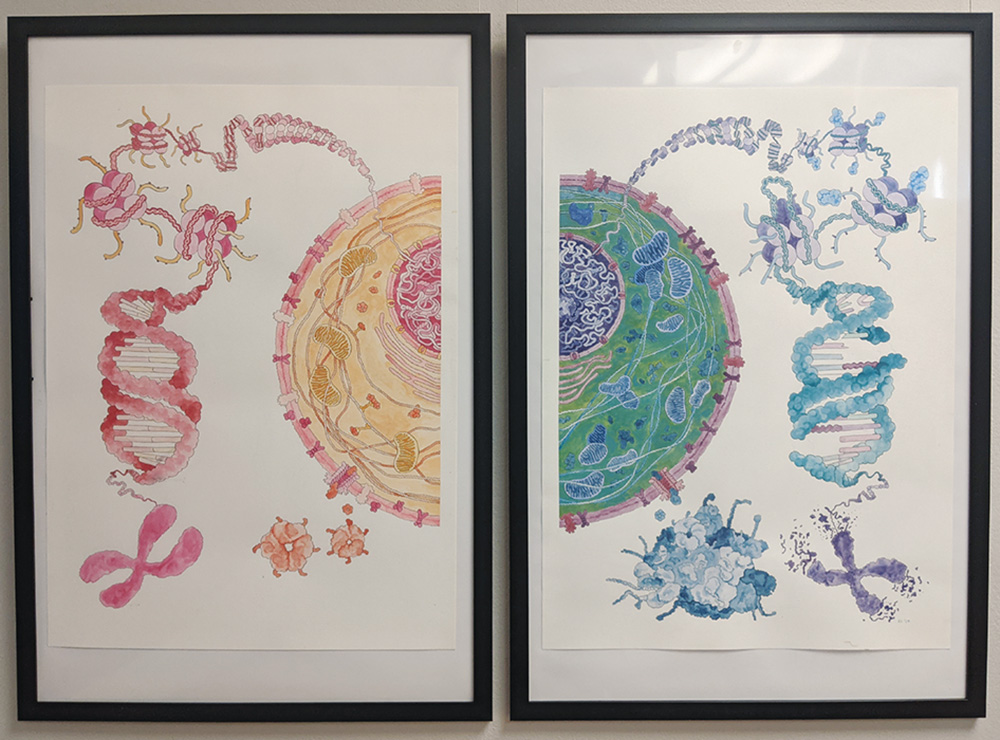
"The Cell-Ebration of Life"
Submitted by Arielle Damiana, Oregon State University ASBMB Student Chapter member since 2024
“A young cell (right) and old cell (left) depict the cellular hallmarks of aging; genomic instability, epigenetic alterations, telomere attrition, disrupted proteostasis and macroautophagy. Some inspiration was taken from David S. Goodsell’s pieces that depict cellular structures and Irving Geis’ depicting more molecular structure. Watercolor and gouache were used to illustrate the aqueous nature of the cell interior.”
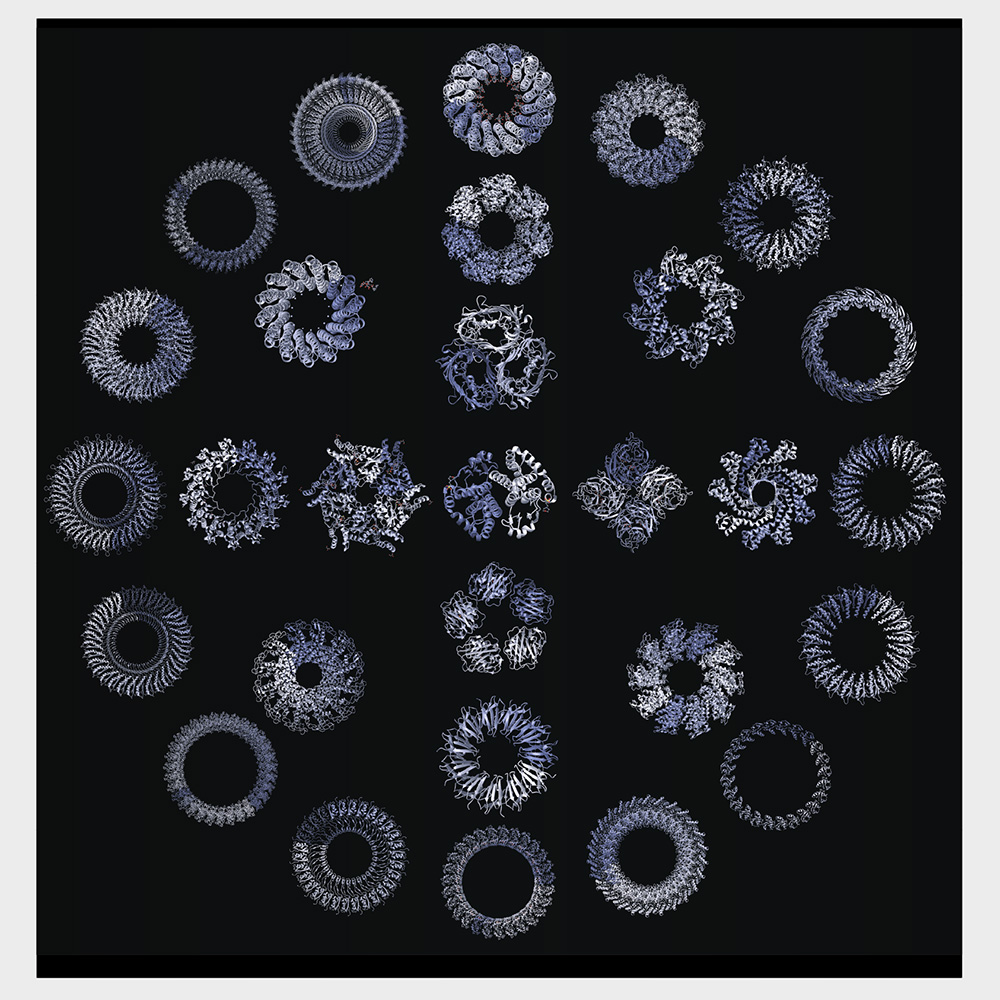
"Flowers of Life"
Submitted by Soutick Saha, Wolfram Alpha LLC, ASBMB member since 2023
“Proteins are the building blocks of life, and symmetries are ubiquitous in the biomolecular world. Here is a collection of 29 protein structures that look like biomolecular flowers, each representing a different cyclic symmetry type in the RCSB Protein Data Bank. They are created using the BiomoleculePlot3D function of the Wolfram ProteinVisualization paclet.”
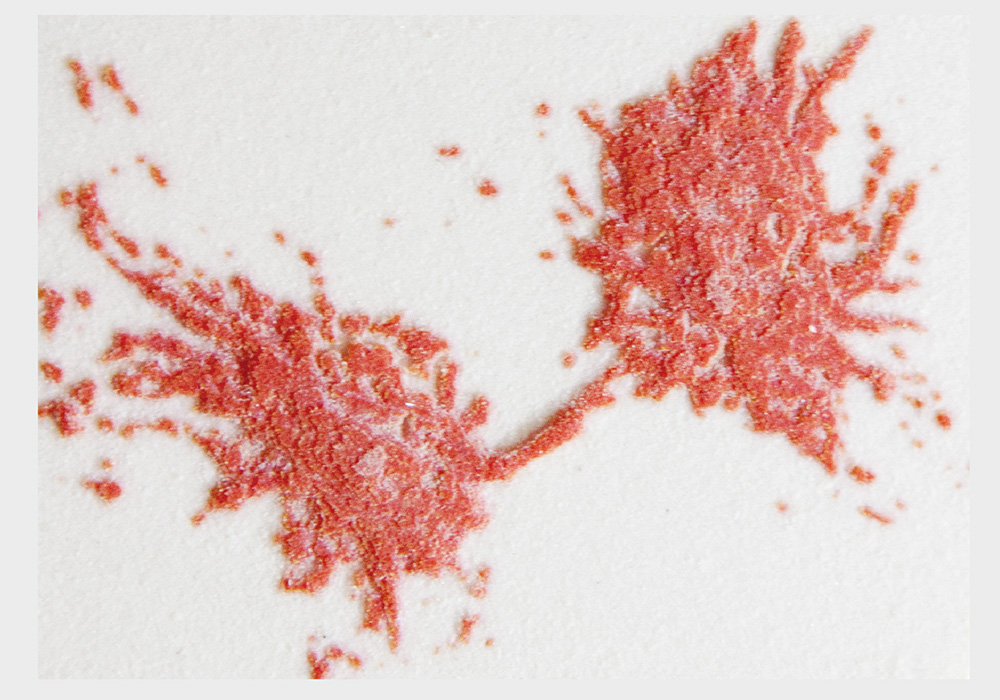
"3D Printed Model Depicting Endothelial Cell Cytokinesis"
Submitted by Vipin Paliwal, Milwaukee School of Engineering, ASBMB member since 1991 (in collaboration with Paul Hausch and Padmanabhan Vakeel)
“This is a 3D printed model of created to tactile teaching cell division. Confocal microscopy image data of human endothelial cells was used for 3D printing. 3D SystemsTM 250 SLA along with DSM Somos’ Watershed® XC 11122 resin was used for 3D printing.”
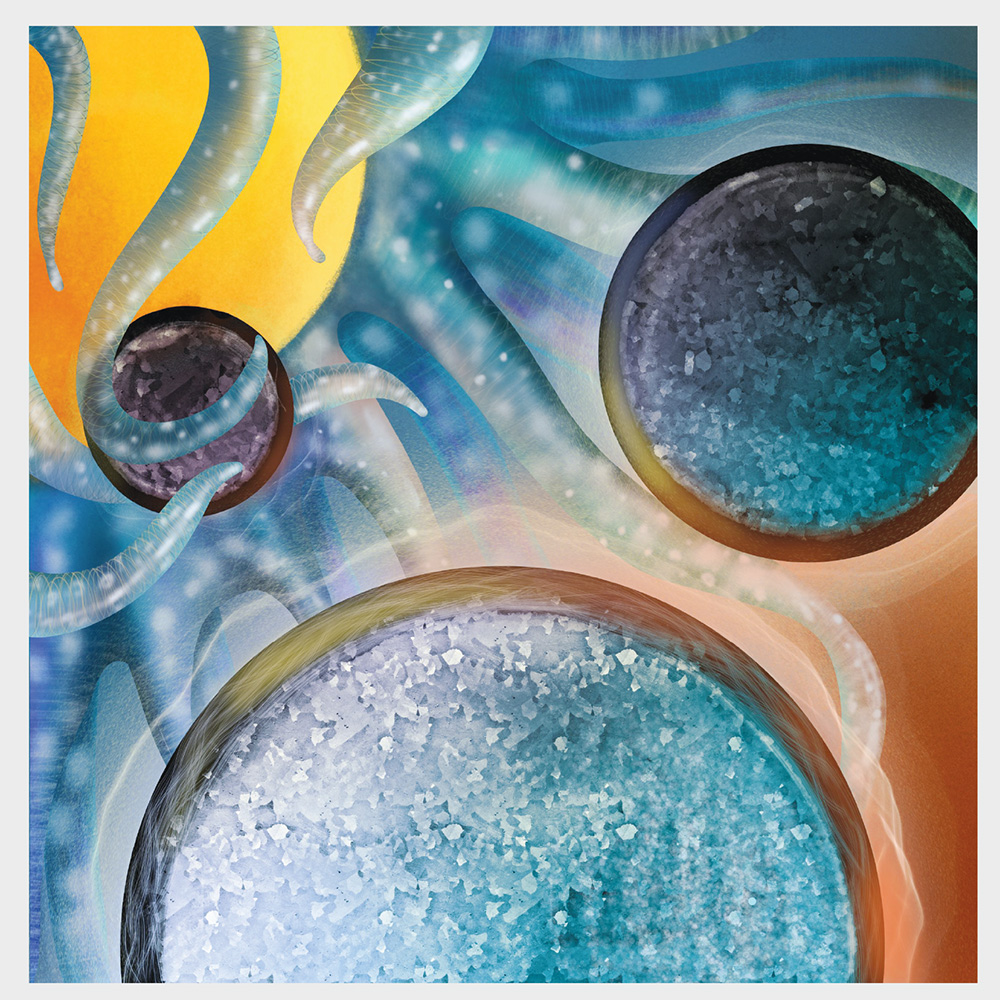
"Nanoparticles and Dendritic Cells: Shaping Autoimmune Arthritis With Immunomodulation"
Submitted by Maksim Dolmat, University of California, San Diego, ASBMB member since 2023
“This artwork explores the development of nanoparticles, conjugated with joint-specific peptide antigens and encapsulating calcitriol. These nanoparticles modulate autoimmune arthritis by influencing dendritic cell behavior and immune responses both in vitro and in vivo, showing potential for managing disease flares without broad immune suppression.”
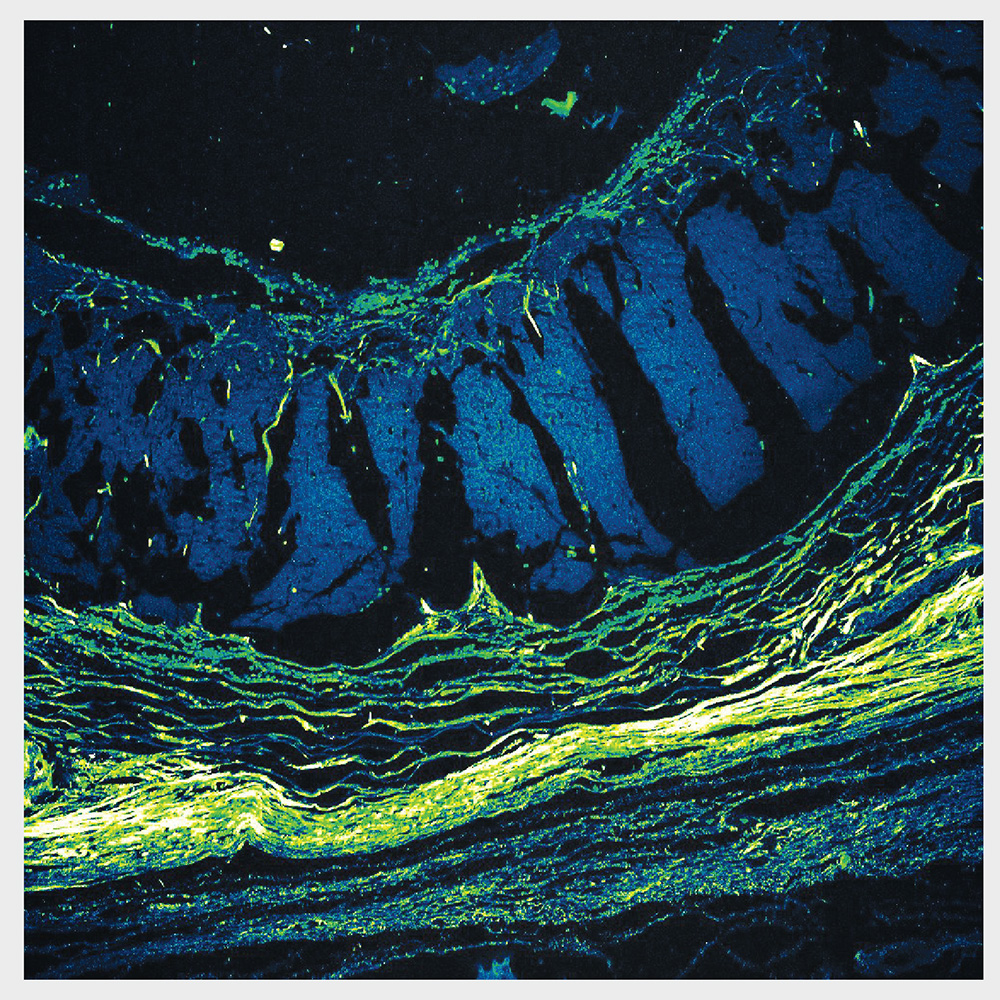
"Second-Harmonic Generation Imaging of Repairing Skull Bone"
Submitted by Maria Paularie, Universidade Federal de Minas Gerais, ASBMB member since 2024 (in collaboration with Bruno Henrique Costa, Emerson Alberto da Fonseca, Leandro M. Malard and Érika Lorena Fonseca Costa de Alvarenga)
“Tissue section of mouse calvarial bone days after injury imaged through Second-harmonic generation microscopy by laser stimulation at the 810 nm wavelength peak, reveals changes in collagen organization and tissue remodeling. Autofluorescence displayed in blue and collagen in green.”
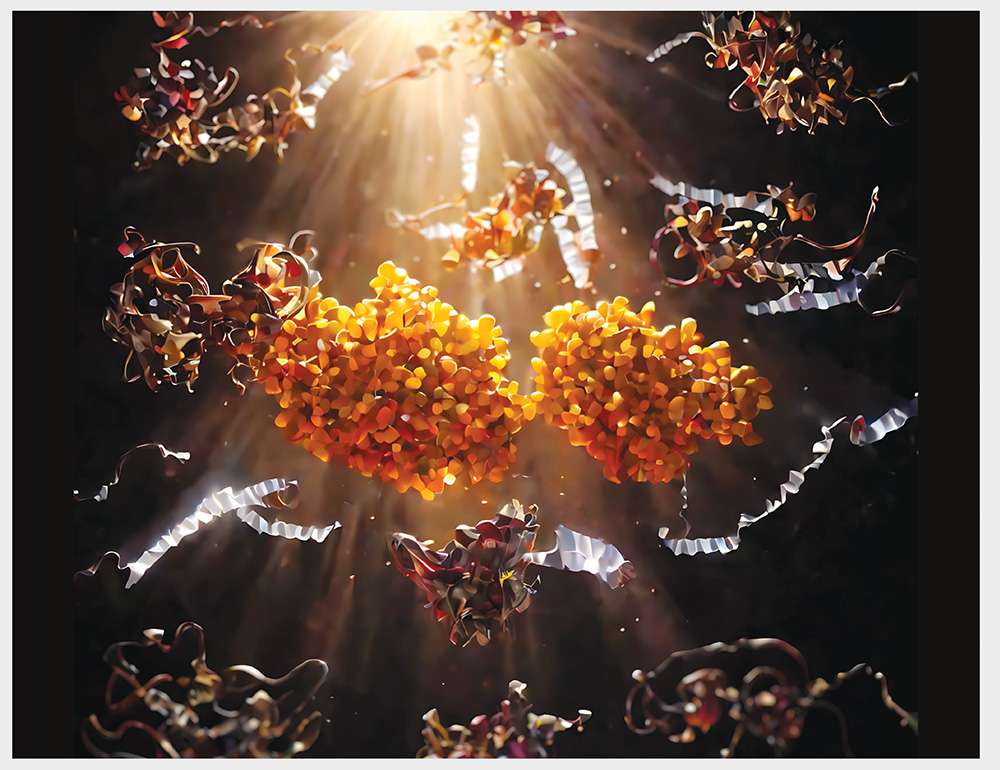
"Guardian of the Cell"
Submitted by Megan Mitchem, University of North Carolina at Charlotte, ASBMB member since 2024
“Heat shock protein 70 plays a key role in the response to nearly every type of cellular stress, from DNA damage to starvation and, of course, heat shock. Hundreds of proteins rely on this molecular chaperone's fidelity, and no cell can survive without it, earning it the title ‘Guardian of the cell.’”
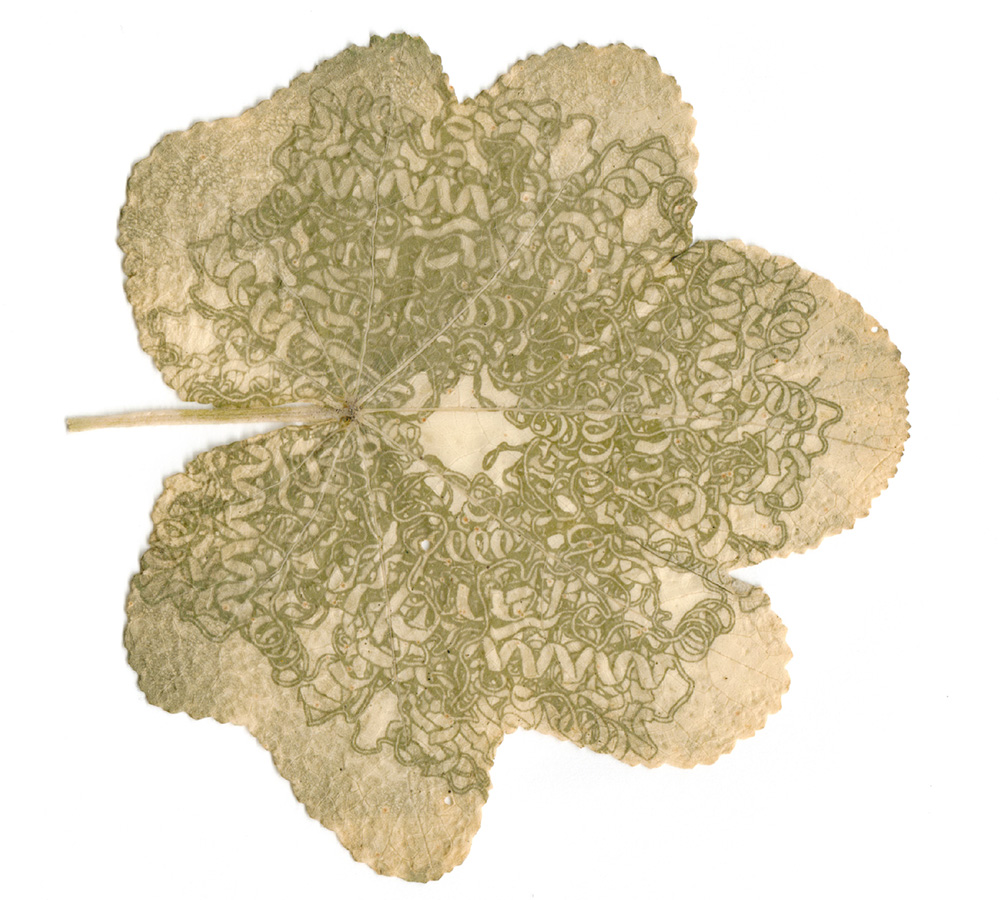
"RUBISCO and Chlorophyll"
Submitted by Marilee Benore, University of Michigan at Dearborn, ASBMB member since 2001 (in collaboration with Rachel Pricer)
“This is a simple type of photography, an image placed over a leaf, and left in the sun many hours. I make cyanoprints, and wanted to try this type of real-sun print!"
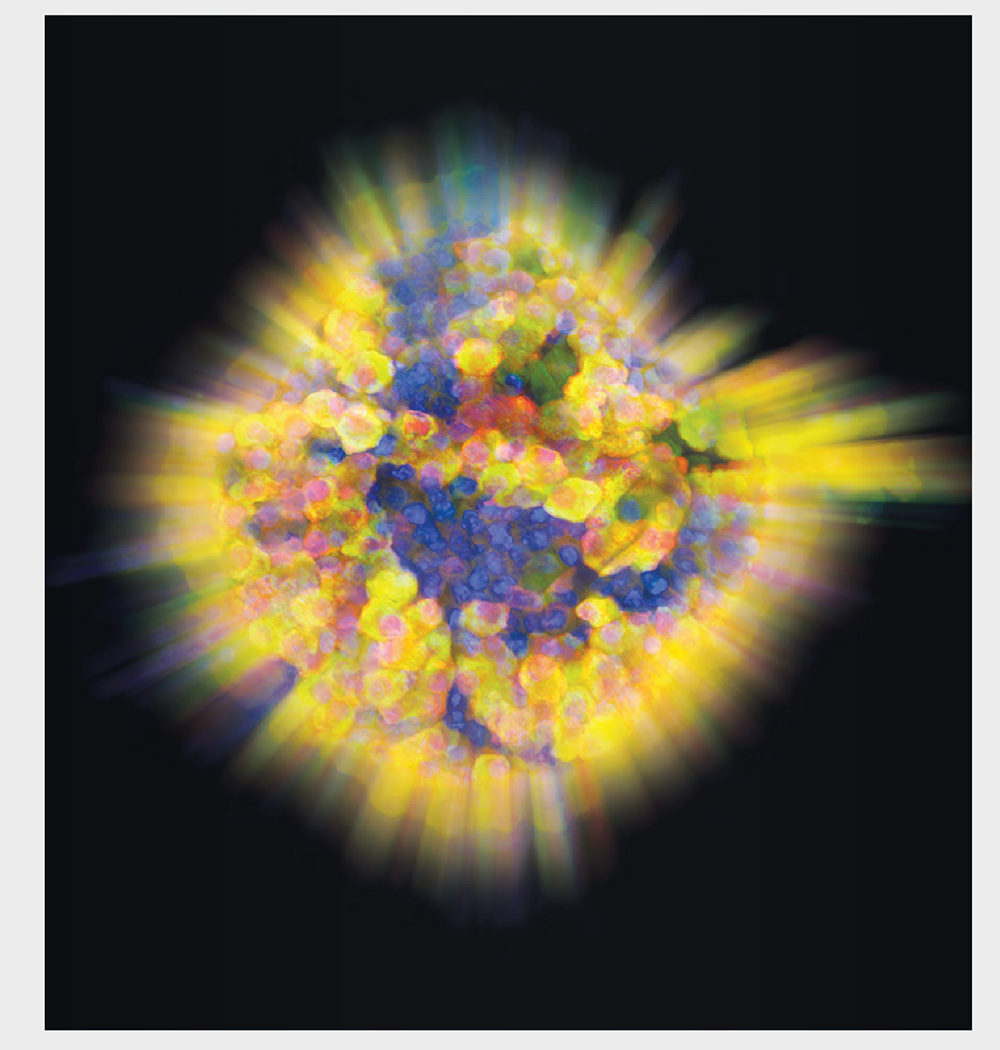
"Exploding Islet"
Submitted by John Corbett, Medical College of Wisconsin, member since 1993 (in collaboration with Bryndon Oleson)
“Immunofluorescence was performed on rat islets of Langerhans using antibodies to insulin (green) and inhibitor of protein phosphotase 1 (IPP1, red), with nuclei stained with Hoechst 33342 (blue). Scale bar, 25 mm”
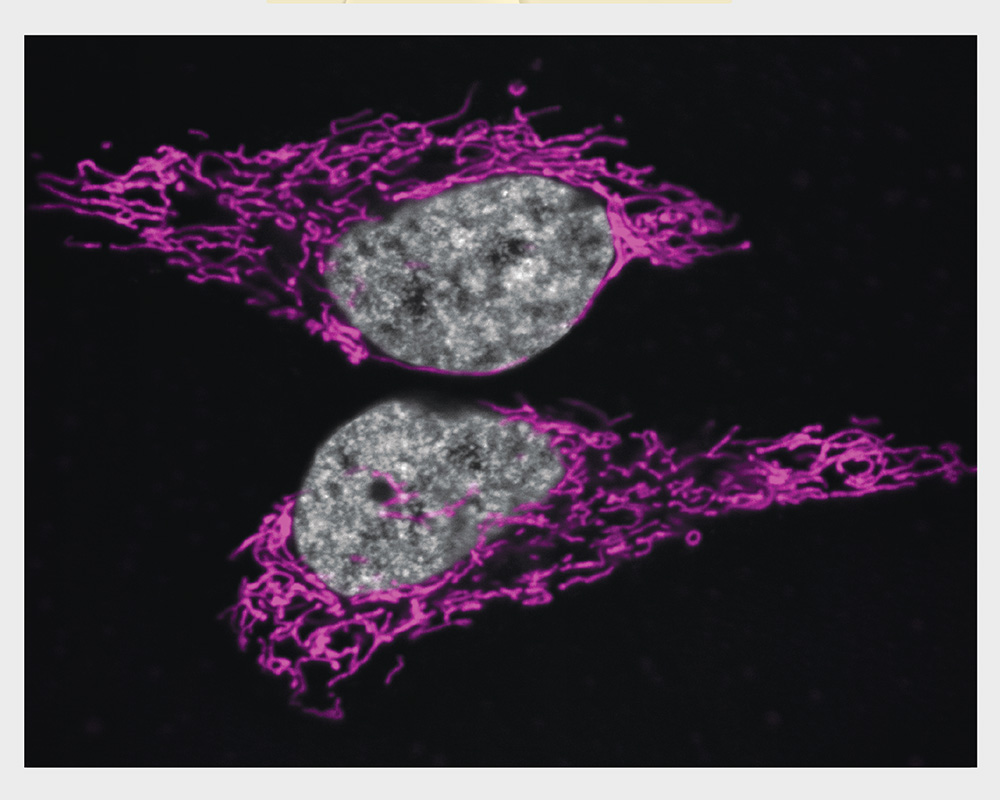
"The Complex World of the Mitochondria"
Submitted by Luis Cedeño-Rosario, University of Utah, member since 2024
“‘The complex world of the mitochondria’ science art piece is a confocal microscopy image of an epithelial cell. Herein, we can appreciate the beauty and complexity of the mitochondrial network that allows a cell to perform many metabolic pathways, in addition to energy production. In this art piece, the mitochondrial network is shown in magenta and the cell nucleus is shown in gray.”
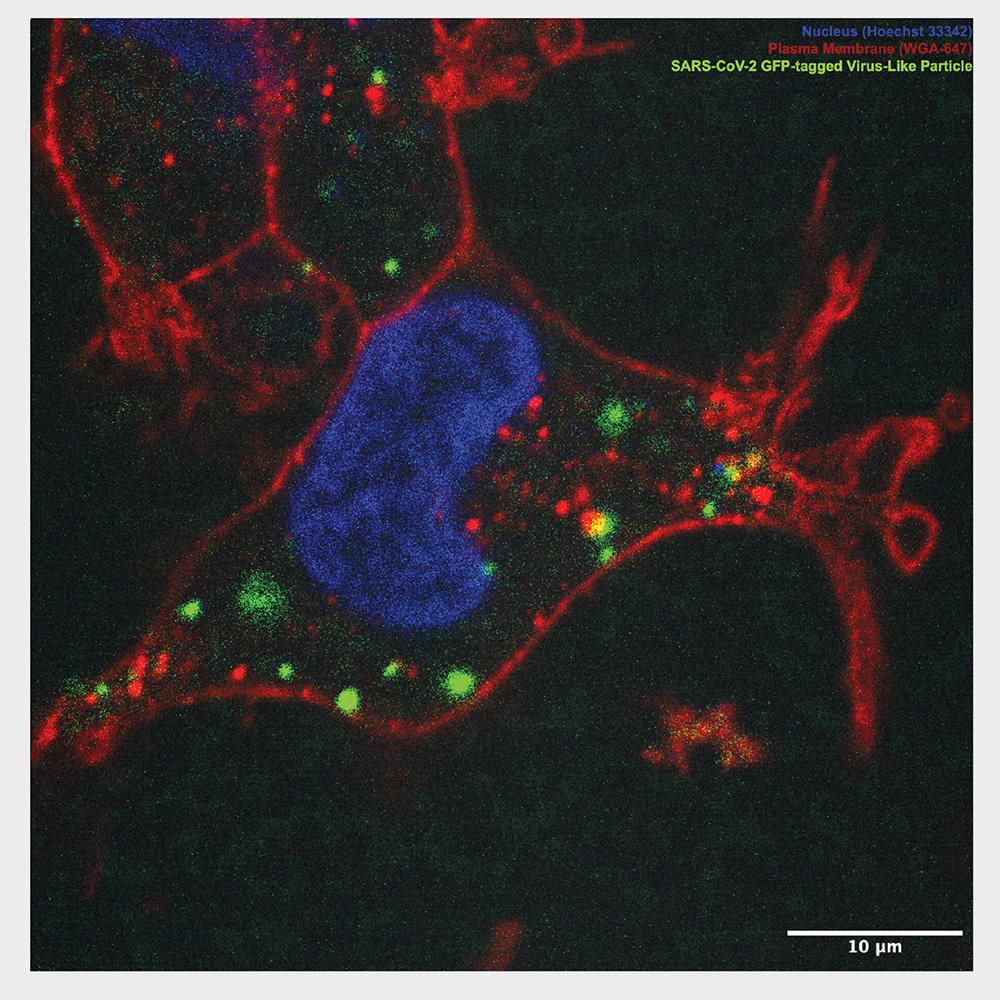
"SARS-CoV-2 Virus-like Particles Entering a Human Cell"
Submitted by Caroline B. Plescia, Purdue University, ASBMB member since 2021, and Robert V. Stahelin, Purdue University, ASBMB member since 2007
“SARS-CoV-2 virus-like particles are particles which morphologically and functionally resemble the authentic live virus but lack the viral genome. These particles were produced with a fluorescent GFP tag, collected and then added to HEK293 cells in culture that were stained with a blue nuclear stain and red plasma membrane stain so that viral entry events could be observed on the confocal microscope. The green puncta are accumulations of GFP-tagged virus-like particles within cellular endocytic vesicles.”
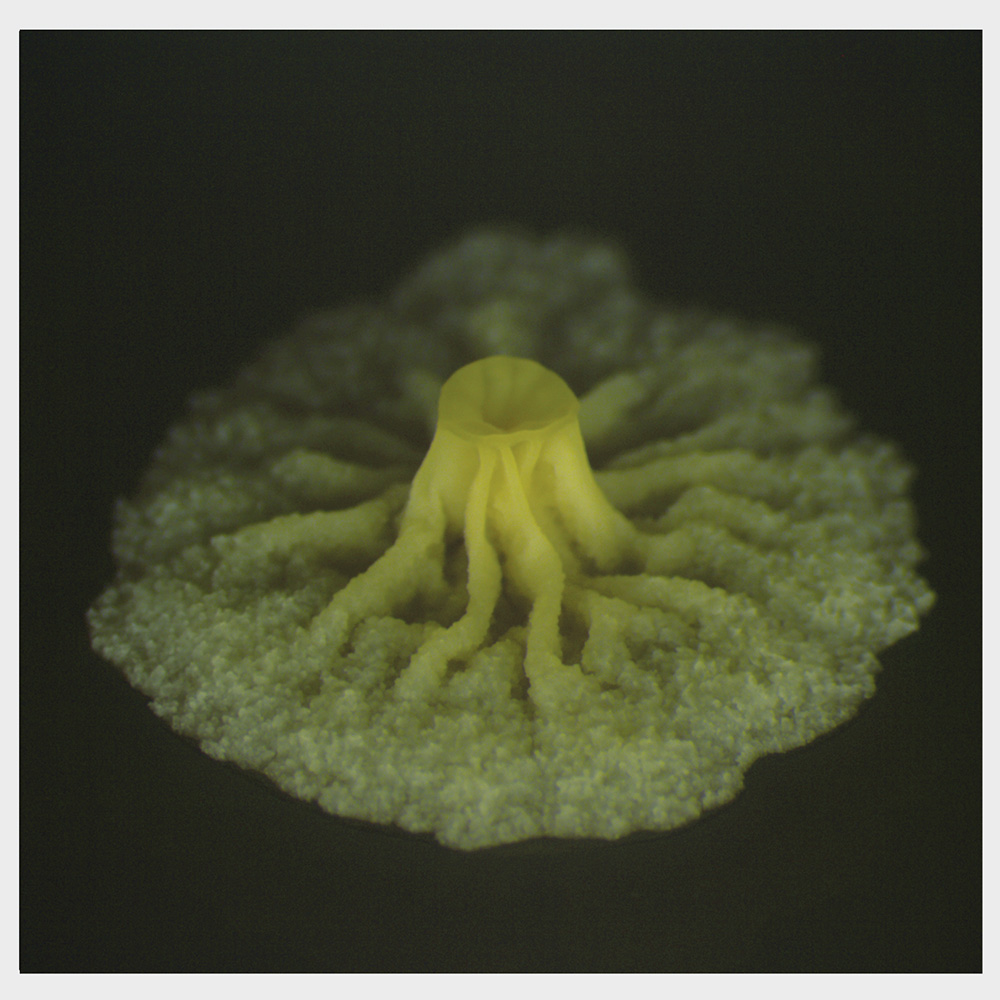
"Bacillus vallismortis Biofilm on LBGM Medium"
Submitted by Nicole Cavanaugh, Northeastern University, ASBMB member since 2019
“This strain of Bacillus vallismortis was isolated in the Atacama Desert. On solid LBGM biofilm growth medium, it often creates a unique 3-dimensional structure, forming a stalk in the middle that resembles a flower.”
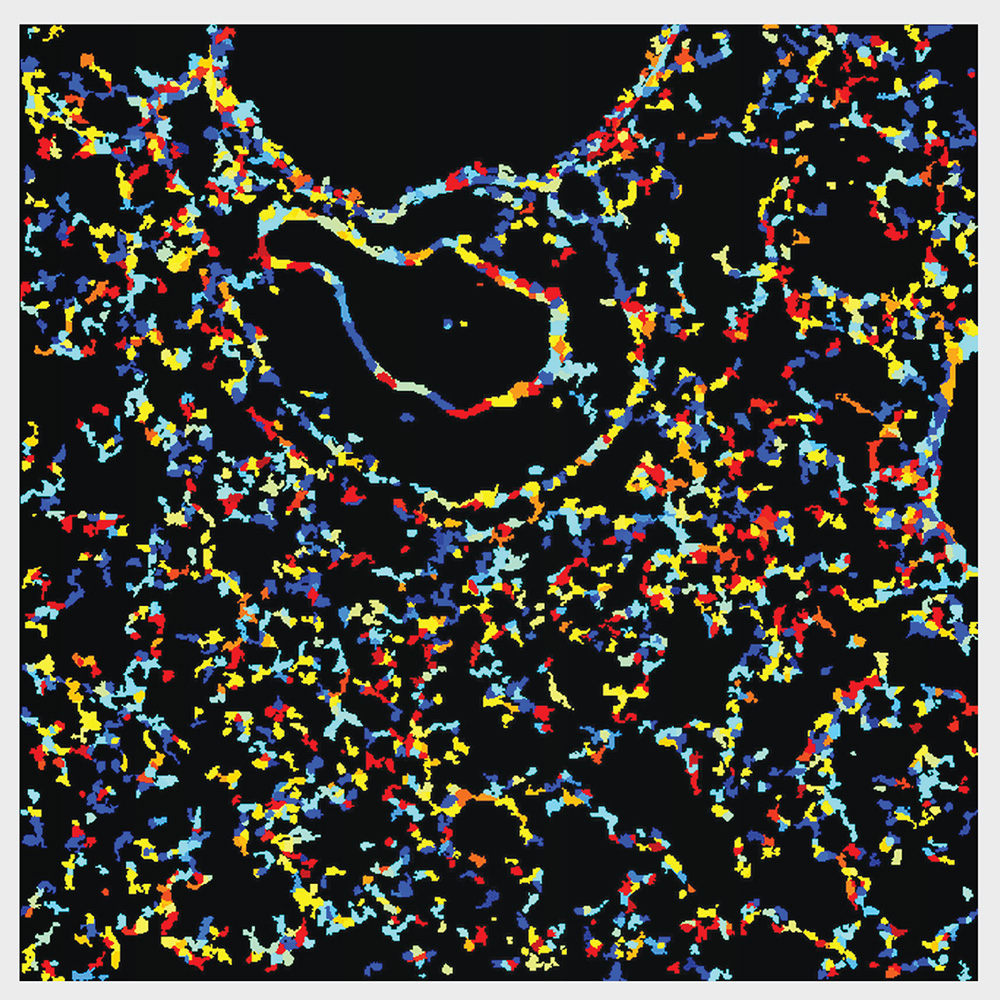
"Cellular Symphony: Harmonious Collaboration and the Impact of Environmental Toxins"
Submitted by Xuejian Huang, University at Buffalo, ASBMB member since 2024 (in collaboration with Anna Blumental-Perry and Vinicius Motta)
“Cells, like people, work together harmoniously, as depicted in this kaleidoscope of cellular collaboration making breathing possible. However, when exposed to harsh environmental toxins, cells become stressed and send warning signals to each other, which can lead to dysregulated cooperation and diseases such as chronic obstructive pulmonary disease.”
Enjoy reading ASBMB Today?
Become a member to receive the print edition four times a year and the digital edition monthly.
Learn moreGet the latest from ASBMB Today
Enter your email address, and we’ll send you a weekly email with recent articles, interviews and more.
Latest in People
People highlights or most popular articles

Embrace your neurodivergence and flourish in college
This guide offers practical advice on setting yourself up for success — learn how to leverage campus resources, work with professors and embrace your strengths.

Survival tools for a neurodivergent brain in academia
Working in academia is hard, and being neurodivergent makes it harder. Here are a few tools that may help, from a Ph.D. student with ADHD.

Quieting the static: Building inclusive STEM classrooms
Christin Monroe, an assistant professor of chemistry at Landmark College, offers practical tips to help educators make their classrooms more accessible to neurodivergent scientists.

Hidden strengths of an autistic scientist
Navigating the world of scientific research as an autistic scientist comes with unique challenges —microaggressions, communication hurdles and the constant pressure to conform to social norms, postbaccalaureate student Taylor Stolberg writes.

Richard Silverman to speak at ASBMB 2025
Richard Silverman and Melissa Moore are the featured speakers at the ASBMB annual meeting to be held April 12-15 in Chicago.

Women’s History Month: Educating and inspiring generations
Through early classroom experiences, undergraduate education and advanced research training, women leaders are shaping a more inclusive and supportive scientific community.
